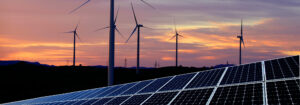Senate Democrats “Reconciliation” Package Includes Significant New Climate and Clean Energy Deployment Proposals
With the U.S. Senate passing the bipartisan “Infrastructure Investment and Jobs Act” last week, attention in Congress now turns to the Senate Democrats “budget reconciliation” resolution, a much larger $3.5 trillion spending and investment legislative proposal. The budget resolution aims to pass the Senate with only Democratic votes, but is important in the U.S. House, where left-leaning Democrats have said that they will only approve the bipartisan infrastructure package if the Senate reconciliation budget proposal also comes to a vote.
We wanted to highlight a few of the climate and energy provisions within the Democrats’ budget reconciliation package. You can see a full memo on the proposals’ contents here. In general, the proposal would focus and spend heavily on deployment of clean energy and emissions reducing technologies, whereas the bipartisan bill has more provisions related to updating the electricity grid and providing research and demonstration funding for emerging energy technologies.
- Clean Electricity Payment Program: The cornerstone of the Senate Democrats reconciliation proposal is a “Clean Electricity Payment Program” that would seek to reduce emissions in the electricity sector to 80% by 2030. We need to learn about some details, but it would provide payments to electric utilities (both investor-owned and publicly owned) for reducing emissions based upon their current electricity resource mix and require payments from those electric utilities if they missed key emissions reduction benchmarks. Eligible technologies for investments include solar, wind, geothermal, hydropower, nuclear (including existing nuclear), and possibly partial credit for gas power plants with carbon sequestration. You can see a bit more about the CEPP here.
- Clean Energy and Electric Vehicle Tax Credits: The Senate Democrats plan to include significant new and revised tax credits for renewable energy, electric vehicle, and energy-related manufacturing. The Senate bipartisan bill notably is much smaller in terms of investments in electric vehicles and electric vehicle charging infrastructure than President Biden put in his original “Building Back Better” proposal, so the tax credits here would help to fill that gap. The tax proposal is likely to include elements of a clean energy tax credit proposal by Senate Finance Committee Chair Ron Wyden (D-OR).
- Clean Energy and Sustainability Accelerator: This is a priority of ours. The national “Clean Energy and Sustainability Accelerator” would provide between $20 billion and $100 billion in seed capital for states that establish independent “clean energy funds,” non-profit entities that would seek to provide low-cost financing to climate resiliency, energy efficiency, renewable energy, electric vehicle, and sustainable agriculture projects. This has already passed the full U.S., but not the U.S. Senate.
- Investments in energy efficiency and electrification in buildings: There are a mixture of funding for programs in the reconciliation package that would seek to promote energy efficiency and electrification in buildings, including federal buildings, public housing, and consumer rebates to weatherize and electrify homes.
- Civilian Climate Corps: The proposal would be modified off of the original Civilian Conservation Corps and would provide money for jobs for folks who want to help with climate resiliency, wildfire mitigation, and forest and wetland restoration projects. The goal is to employ young people in a public program to help.
- Fees on Methane and Imported Pollution: There are proposals that would seek to reduce greenhouse gas emissions by putting a fee on methane emissions and also a sort of “border adjusted carbon tariff” that would put a price on the higher embodied emissions from imported goods (like steel).
- Transition funds for communities that rely on fossil fuels: The reconciliation blueprint would also provide new funds to expand the Appalachian Regional Commission and Economic Development Administration to seek to help communities depending on mining and fossil-based energy and power to transition and diversify their economies.






